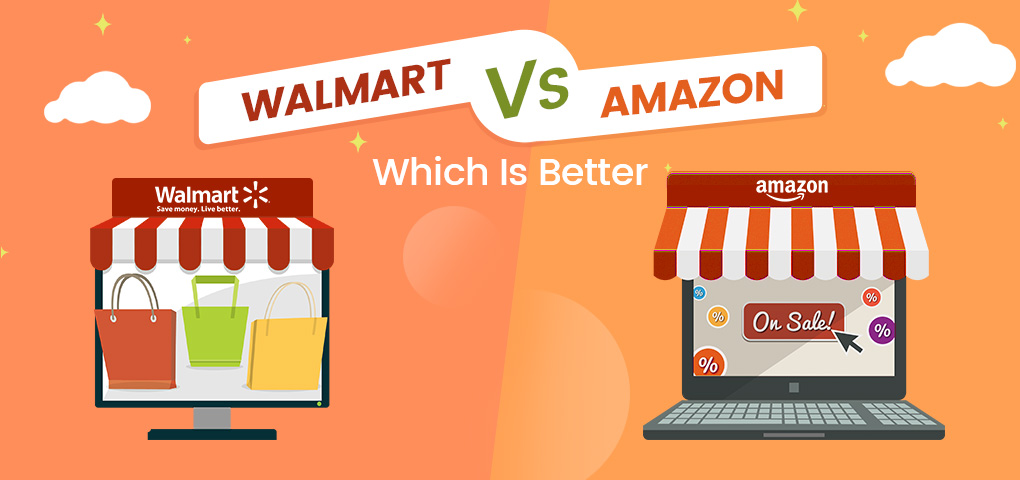It is no longer strange that even the world's remote places where internet connection can be accessed know that there is an online marketplace. It provides different sellers with opportunities to display goods and services on electronic commerce sites. Over 100 of them exist, but the two largest ones which are in continuous competition are Walmart and Amazon. And this continuous competition has led to innovation and additions of new products and services over the years.
In this article, we're trying to find out the differences between Walmart and Amazon, and conclude which one is a better sales platform for online retailers.
Walmart vs Amazon: Overview
The age of the existence of Walmart vs Amazon dated back to 1962 when Walmart was founded, it was 30 years later in 1994 that Amazon arrived. Amazon had started online as an online bookseller while Walmart had started with a physical presence dealing in grocery and as big box stores.
But over the years, the gap between them has narrowed as Amazon creates and increases its physical presence while Walmart creates and increases its e-commerce presence.
The increasing competition exposes the Amazon vs Walmart competitive analysis.
Walmart leads in its physical presence with over 5000 stores in the USA while Amazon leads with its online presence in respect to Amazon vs Walmart competitive analysis. Walmart's total equity is about 79.6 billion dollars and that of Amazon is about 43.55 billion dollars.
As regards the Walmart vs Amazon revenue, the fiscal year of 2020 which was affected negatively by the COVID-19 pandemic saw Walmart making $524 billion and Amazon making more than $386 Billion.
In terms of innovation, Amazon seems to be ahead of Walmart. From the American Customer Satisfaction Index, Amazon ranks ahead of Walmart. In terms of digital growth, Amazon is dominating. Amazon is investing hugely in retail physical presence, it still falls behind Walmart.
Selling on Walmart vs Amazon: Comparison
All online marketplaces have regulations for operations. There are some key distinctions sellers should understand to get the best out of both markets. Walmart and Amazon will be compared in the following aspects:
1. Selling fees;
2. Onboarding and listing;
3. Price and buy box competition;
4. Shipping and fulfillment;
5. Performance standards;
6. Branding and advertising opportunities;
7. Overall sellers' satisfaction.
1. Selling Fees
Walmart:
To start selling on Walmart, there needs to be an approval process based on invitation and having had a fine track record from other online marketplaces. And the process of approval could take 2-3 weeks.
Amazon:
Selling on Amazon is quite easier. Sellers can register without a monthly fee or Professional Sellers for $39.99 per month without any approval process. Referral fees usually range between 8% and 15%. Amazon also demands a minimum referral fee per category. The majority of sellers also pay Amazon FBA fulfillment fees, which are either determined by unit or weight.
2. Listing
Walmart:
Sellers on Walmart can create a listing for their product in two ways either by a new listing or share an existing listing for an item by using SEO keywords, high-quality product images, and correct categorization.
Amazon:
The same process applies except that Amazon sellers with products on shared listings should aim to win the Buy Box for the highest sales volume.
3. Pricing and Buy Box Competition
Walmart:
Pricing is mainly determined by two pricing rules: price parity and price leadership.
Amazon:
To win a Buy Box is dependent not only on item availability and competitive pricing but also on fulfillment and customer service. Amazon doesn't specify how much each factor is considered when picking the Buy Box winner.
4. Shipping and Fulfillment
Walmart:
Walmart started its loyalty program to rival Amazon Prime, making fast shipping a priority as the company offers free, unlimited same-day shipping on all grocery items and other items. Walmart also offers free two-day shipping for any orders over $35.
Amazon:
Sellers now enjoy free shipping on both two-day and next-day deliveries. This allows most of them to use Amazon FBA to gain access to the Prime badge which has become necessary to compete on Amazon.
5. Performance Standards
Walmart:
As a seller on Walmart, it is expected that you keep an order defect rate (ODR) at less than 2%, and On-Time Shipment rate above 99%, and maintain a valid tracking rate above 99%.
Amazon:
As a seller on Amazon, it is expected that an order defect rate (ODR) is maintained under 1% for 60 days. A cancellation rate at or below 2.5 % over 7 days be maintained and a late shipment rate at or below 4% over both 10-day and 30-day periods, for seller-fulfilled orders only.
6. Branding and Advertising Opportunities
Walmart:
Walmart has an approval process barrier to entry and the marketplace has fewer sellers than Amazon. This technically means less competition. It is less saturated with advertising. Walmart is traditionally known for the brand and there is a high tendency for buyers to search for products by brands.
Amazon:
Buyers who search for products on Amazon are looking for a type of product rather than a specific brand. This reveals the importance of advertising to create brand awareness and increase the sale.
7. Overall Seller Satisfaction
Walmart:
Walmart Seller Center is tough to navigate due to the basic tasks that can be tedious. It seems easier to work through a third-party integration partner than to work with Seller Center directly. There are have been reported cases of long intervals between sales on Walmart and disappointment in sales volume by some sellers. Also, Walmart does not offer a fulfillment service.
Amazon:
Amazon has developed a wide array of user-friendly seller tools which are functional within Seller Central. Amazon helps sellers to manage fulfillment. An effortless and reliable way to handle such on Amazon is by signing up for the marketplace's FBA program. With FBA, Amazon picks, packs, ships, seller's orders can be taken care of.
Walmart vs. Amazon: Which Should You Choose?
Sellers have to consider what makes each of the markets unique and adjust their strategies to reap the benefits.
For instance, Walmart sellers will have to deal with barrier entry, but they are faced with less competition. Still, they were also confronted with more pressure to offer the lowest prices online.
However, Amazon sellers may be grieved by its high competition levels, it's easier to join as a seller and relatively less price-driven. More so, Amazon's online trade volume seems to be about 8 times as large as Walmart's.
After all, on whichever e-commerce websites you are selling products, it's critical to find the right products to sell at low costs. By dropshipping with SaleYee.com, you can enjoy flexible cash flow, because we offer over 30,000 profitable products as well as fast and free delivery from worldwide warehouses! No membership fees required! Just take a few minutes to get started!




